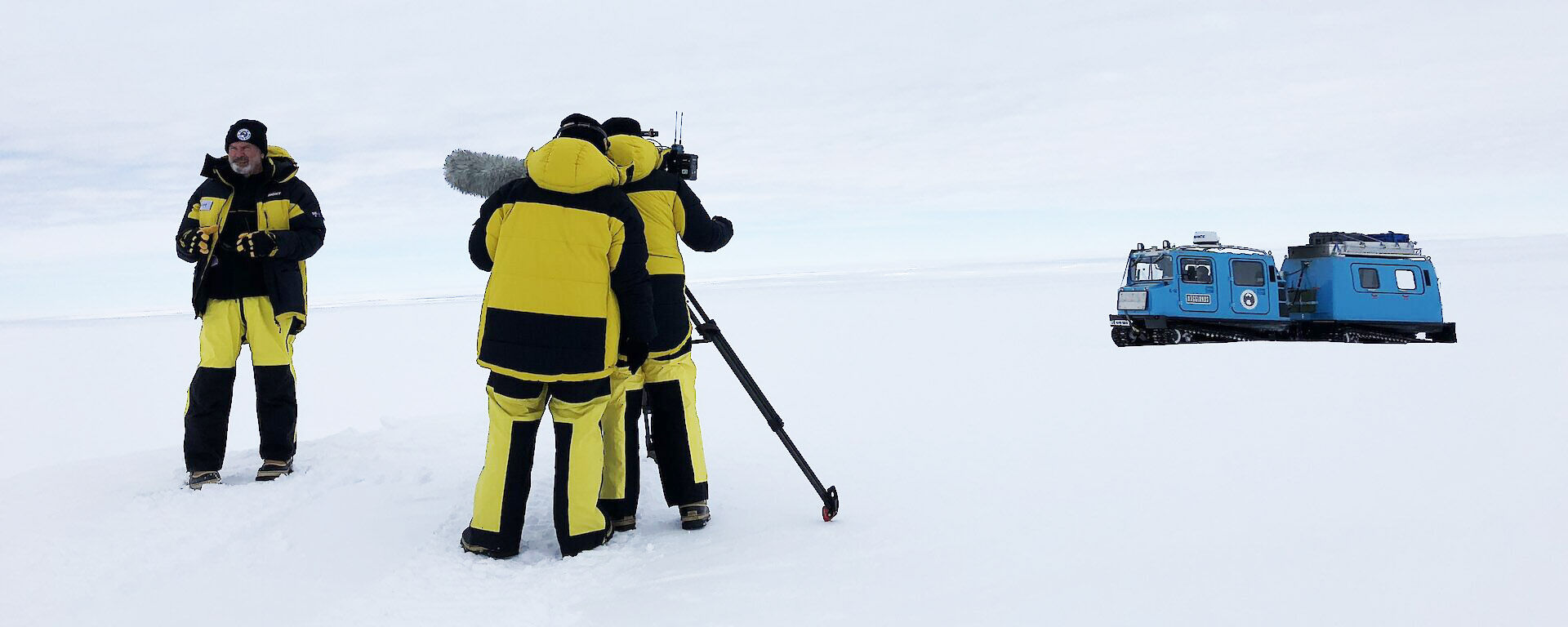Antarctic video gallery
Hide and seek with giants
Video transcript
It's almost like finding a needle in a haystack, which is unbelievable considering how large those animals are.
We deploy satellite tags onto large whales, and we also take biopsy samples from large whales, and both these techniques can give us data streams that are critical to the conservation and management of whales.
So essentially we wouldn't have to put people in a small boat in the Southern Ocean, we'd simply be flying the drone above the whale.
Three, two, one.
Three, two, one.
So we're going to calculate velocity, force of impact and look at the flight path.
There's only ever two tags been put out on an Antarctic blue whale, so that gives you an idea of how difficult it is. So obviously Antarctic blue whales are incredibly hard to find in the first place, they're an endangered species, there's only a few thousand down in Antarctica.
The work that we do is always challenging, always interesting, so it's not hard to get up every day and do the job that we do, because we work on some really interesting animals, we use some really interesting techniques to answer our questions. So, it's a lot of fun actually.
[end transcript]
Saving Seabirds
Video transcript
Dr Barbara Wienecke: I can't understand anybody who doesn't feel deeply deeply moved by these beautiful beautiful birds, who really spend so much of their life in the air without beating a wing. It's extraordinary.
Dr Graham Robertson: I don't think I've ever seen a group of animals so beautiful. You could see an albatross on a nest and it's so impeccable that if you imagine if there's a small ant crawling up its breast you think I must brush that off, it's just spoiling the image.
Dr Barbara Wienecke: And you just look at these absolutely perfect birds, just dead and there's nothing you can do. Not for them anymore at least. You know so that it really it really motivates you to think, you know how, how can we make the fishing safe.
When the small divers hit the water and they probably focus on a particular bait in front of them and and follow it. But because the line is moving so fast what they don't realise is that there is a hook behind them.
Dr Jaimie Cleeland: When that egg hatches it takes quite a long time before the chick fledges and that chick may be at sea for between five to fifteen years before it will return to the colony and breed again. So any increase in the population may only be seen between five and fifteen years down the track.
Dr Graham Robertson: I mainly focused on methods to expedite the sink rate of the baited hooks in the upper reaches of the water column, and sort of applied that through all the main commercial longline fisheries that take seabirds in the world. Just work through them all systematically.
Longline fishery in the CCAMLR convention area, that's the Southern Ocean, is albatross friendly and has been for a long time and I'd say that's probably the global best practice. I can't think of a better example.
When you work in trying to change a fishing practice, or any form of primary industry I suppose, where people are making their living, it ain't easy to make changes.
Dr Jaimie Cleeland: We know albatrosses don't abide by geopolitical boundaries and they cross wide ocean basins and so those threats are uneven through the ocean. And that means that we're not actually seeing huge improvements at the breeding colony just yet.
Dr Kim Kliska: Decades of conservation and monitoring work here on Macquarie Island by the Tasmanian Parks and Wildlife Service, the Australian Antarctic Division and DPIPWE, are paying off. Threatened seabirds have begun to recover here since the vertebrate pests were eradicated on this World Heritage listed island in 2014. On Macquarie Island we have four species of albatross and lots of different seabirds, and since the eradication the habitat for all these species has improved, with the tussocks returning to the slopes and the vegetation growing. The black-browed albatross that was listed as endangered is now considered to be of least concern. But these species still face threats because a large part of their life is lived at sea in places that are really hard to protect.
Dr Jaimie Cleeland: I hope that we can continue to work together across fisheries management, across island conservation, and with our climate change strategies, to really create a better world for albatross.
[end transcript]
Derek Stevens is bound for Macquarie Island
Video transcript
ANTARCTIC STATION LEADERS: SEASON 2021
DEREK STEVENS, Macquarie Island research station
I think the main thing for me is just the uniqueness of the experience, I think the big attraction is it’s pretty hard these days to find something which is different and unique and Macca definitely fits the bill.
New Zealand’s home for me, Australia’s home to me but I sort of moved to New Zealand eight years ago, I live in a town called New Plymouth which is on the west coast of the north island, and yeah, here I am.
The role’s predominantly around your people skills and your ability to lead and motivate and coach teams. I’ve been doing that for most of my life. I sort of started life in the military and in the last couple of years I’ve been working in engineering and construction, working in many different places and countries. It’s a pretty good background to do what I’m doing now.
The biggest thing to keep the community together is a sense of identity, you know it’s the sense of identity and shared purpose and us sort of agreeing how we work and relate and behave as a team, and it’s just making sure we have a nice strong team culture that we sort of build up in the good times and is there to help us when inevitably, things get a bit rougher at times throughout the year.
I was lucky enough to go sort of March last year, as a familiarisation trip. So I was involved in the resupply, I got to meet the team down there and have a good look around the island, which was fantastic to help me prepare for this season.
I think the main unique thing about Macca is just the wildlife. Just the immense depth and variety and the sheer numbers of the wildlife and being able to follow that through the seasons, we’re lucky to be able to have the ranger team and the wildlife rangers come with us. And we’ve already started getting briefed and just what we’re going to see on a month-by-month basis and I think for all the expeditioners, it’s one of the things they enjoy the most.
[end transcript]
Incoming Station Leader Esther Rodewald is looking forward to life on Davis
Video transcript
Esther Rodewald, Davis station leader
I’ve always wanted to do Davis. Davis was the one that came up first for me and there was a shift in personnel and I ended up going to Macquarie. So Davis has always been kind of on the radar as somewhere to go.
Starting with Macquarie Island which is sub-Antarctic but has the most incredible wildlife, so you feel like you’re living in a David Attenborough documentary every day, was just an extraordinary introduction. Antarctica’s different because it’s much more about the weather and the environment rather than the wildlife, but I’m interested to see how different Davis is to Mawson.
Always going somewhere different, it’s always different people so no two years are ever the same, even if you’re going to the same place.
It’s great when it works. Yeah it is a good feeling and it’s nice to see the relationships that they form separately and to see what holds on and what doesn’t when you come home.
You have to have hobbies and you have to be able to occupy yourself.
Knitting, reading, a few different hobbies to keep me through. And then the opportunity to actually get out into the field and be outside is so extraordinary that that’s quite motivating too.
It’s a people job for me. If everybody is down there to do their job and they’re all perfectly competent at doing their job, then for me it’s a lot more, pastoral care I think is the term they use. The emphasis is a lot more on the community. Summer’s busier, for station activities and for health and safety and all that kind of stuff, but over winter it’s a lot more, getting people through and getting the community through.
[end transcript]
Jason Ahrens is bound for Mawson research station
Video transcript
This will be my sixth season in Antarctica, so I’ve wintered previously at Macquarie Island, Davis three times and Casey once.
Mawson’s a place that I’ve been very keen to get to and I’ve put my hand up a couple of times to get there and haven’t managed to do that.
It’s going to be pretty exciting to go to Mawson for the first time and I’m really looking forward to getting out and seeing the Emperor penguin colonies.
We’ve got a good mix of returning expeditioners and quite seasoned expeditioners. We’ve got some expeditioners who’ve done multiple seasons, we’ve got a handful of expeditioners who, this is their second season. So they’re quite excited as well. And we’ve got five newbies. And they’re fantastic, they just bring so much energy to the place.
I love the winters, that’s where the challenge is. That’s where the remoteness is and that’s what’s inviting for me, is to challenge myself and to help others get through those periods.
For me it’s rewarding to see people achieve what they want to achieve personally when they go south. For people, that’s different. If I can give them the tools to do that, I walk away happy as well.
The family are great. They love it, they really support me 100% I send back regular emails with photos about what I’m up to.
They love the penguins. Not so much Gramps, but they love the penguins (laughs)
[end transcript]


